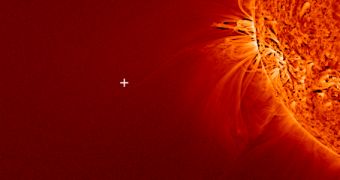Continuous observations carried out by a large number of spacecraft have thus far revealed no sign of Comet C/2012 S1, or ISON, after it reached its point of closest approach to the Sun yesterday, November 28. The object has not resurfaced, apparently confirming that the star utterly destroyed it.
Astronomers hypothesized a few months ago that reaching perihelion could damage the comet beyond repair, but there was no way of knowing for sure until ISON actually made its way to the inner solar system, and then to the Sun.
Scientists with the NASA Solar Dynamics Observatory (SDO) mission say that the comet most likely broke apart due to a host of factors, and that it has since melted away entirely. The NASA Solar Terrestrial Relations Observatory (STEREO), and NASA/ESA Solar and Heliospheric Observatory (SOHO) spacecraft have not been able to identify traces of Comet ISON either.
Solar physicists say that there is yet a chance that the comet might resurface from beyond the Sun, but add that chances of that happening are very small. In all likelihood, solar heat, pressure and radiation combined in a way that the icy space boulder could simply not cope with, Space Fellowship reports.

 14 DAY TRIAL //
14 DAY TRIAL //